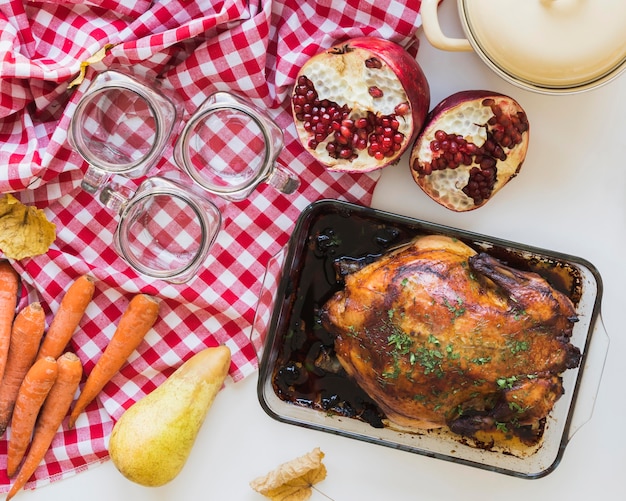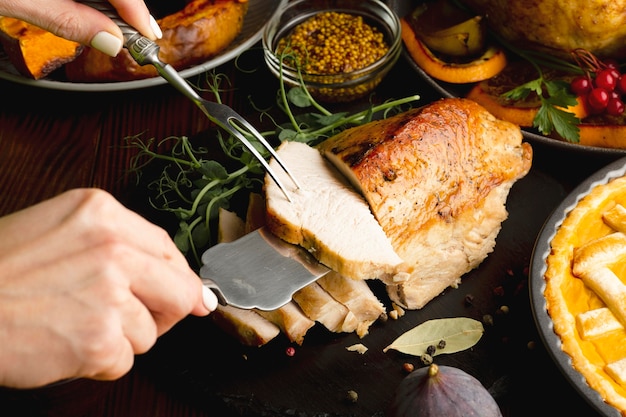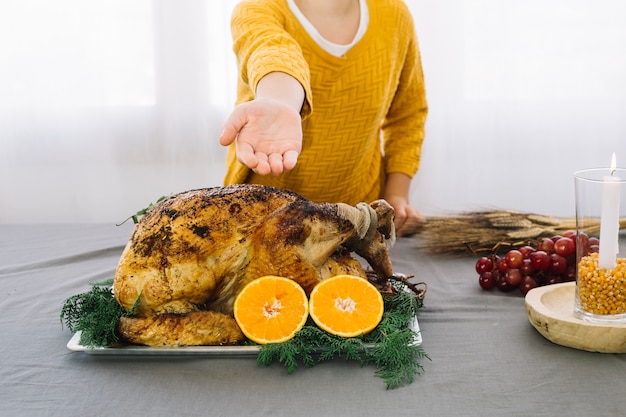Ah, the annual turkey dilemma. Every year, we find ourselves staring down a 15lb bird, wondering how on earth we're going to cook it without turning it into a dry, rubbery nightmare. I've been there myself, grappling with oven thermometers and timers, hoping for the best. But fear not, my friends! This guide is here to banish those doubts and anxieties, arming you with the knowledge to confidently roast a 15lb turkey that's juicy, flavourful, and perfectly cooked.
Let's dive into the science of turkey cooking, debunk some myths, and explore the secrets of achieving that perfect golden-brown, succulent bird. Grab a cuppa, settle in, and let's get cooking!
(Part 1) Understanding the Basics

Why Size Matters: A 15lb Bird is a Beast!
Let's be honest, a 15lb turkey isn't your average Sunday roast chicken. It's a behemoth! And that size makes a world of difference when it comes to cooking time. The key to success is acknowledging that bigger birds need longer to cook through.
The Science of Turkey Cooking: It's All About Temperature
Imagine the turkey as a giant sponge. We want to cook it evenly, ensuring the internal temperature reaches a safe 165°F (74°C) throughout. The heat from the oven penetrates the turkey, slowly bringing the internal temperature up. But with a larger turkey, it takes longer for the heat to reach the centre, making proper cooking a bit of a marathon.
The Role of Oven Temperature: A Balancing Act
Many people believe that a higher oven temperature will magically speed up cooking time. But in reality, while a high temperature can be tempting, it can also lead to a dry, overcooked bird. The key is to find the perfect balance: a temperature that cooks the turkey evenly without drying it out. That's why we usually aim for around 325°F (160°C), allowing for a slow, gentle cook.
(Part 2) Getting Started: Prepping for Success

Patting It Dry: The First Step to crispy skin
Before we even think about seasoning, we need to prep our turkey for the oven. Start by patting the turkey dry with paper towels. This removes excess moisture, which can lead to a steamed, rather than roasted, bird. And let's be honest, nobody wants a soggy turkey!
Seasoning Secrets: Simple is Best
Now for the fun part: seasoning! Personally, I like to keep things simple. Salt, pepper, and a few sprigs of rosemary or thyme – that's my go-to combination. But feel free to get creative with spice rubs or marinades. Just remember, less is often more. Too much seasoning can overpower the natural flavour of the turkey.
The Brining Debate: To Brine or Not to Brine?
Ah, the great brining debate! Some swear by it, claiming it yields a juicier bird. Others say it's unnecessary and even alters the flavour. Honestly, it's a matter of personal preference. I personally skip the brining process and focus on achieving a perfect roast, relying on proper cooking techniques and careful monitoring.
(Part 3) Mastering the Roast: The Essentials

Choosing the Right Oven: Conventional is King
We've got our turkey prepped, now it's time to choose our battleground – the oven. I recommend using a conventional oven, rather than a fan oven, for a more even cook. Fan ovens can create hot spots, leading to uneven cooking.
Using a Roasting Rack: Letting the Heat Flow
A roasting rack is essential. It elevates the turkey, allowing hot air to circulate freely around it. This ensures even cooking and prevents the turkey from sitting in its own juices, which can lead to a soggy bottom.
Time and Temperature: The Key to Perfection
Now, here's where it gets serious. The golden rule for cooking a 15lb turkey is around 3-4 hours at 325°F (160°C). But remember, that's just a starting point. Several factors can affect cooking time, including:
- Stuffing: A stuffed turkey will take longer to cook, as the stuffing needs to reach a safe internal temperature of 165°F (74°C) too.
- Oven Type: If you're using a fan oven, the cooking time may be slightly reduced.
- Your Oven: Every oven is different. Some run hotter or cooler than others. It's always a good idea to check the temperature with a probe thermometer.
The Best Way to Check for Doneness: Trust the Thermometer
We've all been there, peering into the oven, trying to guess if the turkey is done. But don't rely on your instincts! The best way to check for doneness is with a meat thermometer. The internal temperature of the thickest part of the thigh should reach 165°F (74°C). Don’t rely on the pop-up timer in the turkey – it’s often unreliable.
(Part 4) Turkey Cooking Techniques: Explore the Possibilities
The Classic Roast: Tried and True
This is the tried-and-true method, and it works beautifully. Simply place the turkey on the roasting rack, pop it in the preheated oven, and let it cook for the recommended time. Remember to baste the turkey periodically with its own juices to keep it moist.
The reverse sear: A Slow and Steady Approach
This technique involves cooking the turkey at a lower temperature for a longer time, followed by a quick blast of heat at the end. It's a great way to achieve a juicy, flavorful turkey, especially for those who prefer a more tender texture. Start by cooking the turkey at 250°F (120°C) for 4-5 hours, then increase the temperature to 400°F (200°C) for the last 30 minutes to crisp up the skin.
The Spatchcocked Method: Faster and Crispier
Spatchcocking involves removing the backbone of the turkey and flattening it out. This reduces cooking time significantly, as the heat can penetrate the bird more evenly. You’ll need a sharp knife and a bit of muscle, but it's worth it for faster cooking and crispier skin.
(Part 5) Resting the Turkey: A Crucial Step for Juiciness
Why Resting is Crucial: Letting the Juices Redistribute
Your turkey is cooked to perfection, but the journey isn't over yet. The most important step after cooking is resting. This allows the juices to redistribute throughout the meat, resulting in a juicier, more flavorful turkey.
How Long to Rest: Patience is Key
For a 15lb turkey, aim to let it rest for at least 30-45 minutes before carving. Cover the turkey loosely with foil to keep it warm. Resist the temptation to carve it too soon! Those juices need time to settle back in.
(Part 6) Carving the Turkey: A Skill to Master
The Art of Carving: Against the Grain for Tender Meat
carving a turkey is a skill that takes practice. The key is to carve it against the grain, which helps to keep the meat tender and prevent it from tearing. It's also helpful to use a sharp carving knife to make the process easier.
A Step-by-Step Guide: Making Carving Easier
Here's a simple way to carve your turkey:
1. Remove the legs and thighs. Use a carving knife to cut through the joint between the leg and the thigh.
2. Separate the drumsticks from the thighs. Carve down the inside of each leg, separating the drumstick from the thigh.
3. Carve the breasts. Cut down the breastbone, then carve across the grain to create thin slices.
4. Carve the wings. Cut through the joint to remove the wing, then carve the wing in half.
(Part 7) turkey leftovers: Don't Waste Them!
Making the Most of Leftovers: Creativity in the Kitchen
Don’t let those delicious turkey leftovers go to waste! There are so many creative ways to use them.
Leftover turkey recipes: From Sandwiches to Soups
Here are a few ideas to get your creative juices flowing:
- turkey sandwiches: A classic! Pile some turkey slices onto a crusty roll with your favourite toppings.
- turkey soup: A comforting and nourishing way to use up leftovers.
- turkey pot pie: A delicious and satisfying way to use up leftover turkey, gravy, and vegetables.
- turkey salad: A light and refreshing way to enjoy leftover turkey. Combine it with celery, mayonnaise, and your favourite seasonings.
- Turkey enchiladas: A fun and flavorful way to use up leftover turkey and tortillas.
(Part 8) Troubleshooting Turkey Problems: What to Do When Things Go Wrong
Dry Turkey: How to Prevent and Fix It
It’s a nightmare scenario: a dry, rubbery turkey. The most common causes are overcooking, not basting enough, and using a higher temperature than recommended.
Prevention: Baste the turkey periodically with its own juices to keep it moist, and stick to the recommended cooking time and temperature.
Remedies: If your turkey is already dry, there's not much you can do to salvage it. However, you can try slicing it thinly and serving it with gravy or a sauce to add moisture.
Undercooked Turkey: Safety First!
Don't risk food poisoning! If your turkey isn’t cooked to a safe internal temperature, it needs to go back in the oven. It’s better to be safe than sorry.
Turkey with a Soggy Bottom: Tips for Avoiding It
A soggy bottom is a common issue, often caused by moisture collecting in the pan. You can prevent this by using a roasting rack and making sure the turkey is dry before roasting.
Burnt turkey skin: Keeping It Crispy without Burning
Burnt skin happens to the best of us! To prevent this, you can cover the turkey loosely with foil for the first part of the cooking time. This helps to prevent the skin from burning, while still allowing it to crisp up in the last stage of cooking.
(Part 9) FAQs: Answers to Your Burning Questions
1. How long can I keep leftover turkey in the fridge?
Leftover turkey can be safely stored in the refrigerator for 3-4 days. Just make sure it’s properly wrapped and stored in the coldest part of the fridge.
2. How do I reheat leftover turkey?
The best way to reheat leftover turkey is in the oven. Heat it at 325°F (160°C) until it’s heated through. You can also reheat turkey in the microwave, but it may become a little dry.
3. Can I freeze leftover turkey?
Yes, you can freeze leftover turkey for up to 2 months. Wrap it tightly in plastic wrap and aluminum foil, then place it in a freezer-safe bag.
4. Can I stuff a 15lb turkey?
You can, but it's not recommended. A stuffed turkey takes longer to cook, and the stuffing needs to reach a safe internal temperature of 165°F (74°C). This can make it difficult to ensure both the turkey and stuffing are cooked through. For a safer alternative, consider stuffing the turkey separately and baking it in a casserole dish alongside the turkey.
5. What if I don’t have a meat thermometer?
While a meat thermometer is the most accurate way to check for doneness, you can use other methods. Check for clear juices when you cut into the thickest part of the thigh. The skin should be golden brown, and the turkey should feel firm to the touch. However, remember that these methods are less reliable than using a thermometer.
(Part 10) Final Thoughts: Embracing the Turkey Journey
Remember, cooking a 15lb turkey takes time, patience, and a touch of confidence. Don't be afraid to experiment and find what works best for you. And most importantly, enjoy the process! After all, it’s all about sharing a delicious meal with loved ones. So grab your ingredients, put on your apron, and get ready to create some festive magic. Happy cooking!
Tips for an Even Better Turkey Roast:
Use a Turkey Baster: Basting your turkey regularly with its own juices helps to keep it moist and flavorful.
Don't Overcrowd the Oven: Give your turkey plenty of room to breathe. If you're cooking other dishes alongside the turkey, ensure there's enough space for the heat to circulate properly.
Don't Open the Oven Door Too Often: Every time you open the oven door, you let out heat, which can affect the cooking time.
Remember, you’ve got this! Enjoy the journey, and savor the delicious results of your culinary efforts.
Everyone is watching

Corn on the Cob: The Ultimate Guide to Perfectly Cooked Ears
Healthy MealsAh, corn on the cob. Just the name evokes images of sunny days, barbecues, and that sweet, juicy flavour that ...

Scallops: The Ultimate Guide to Perfect Cooking
Healthy MealsAh, scallops. Those delicate, sweet, and utterly delicious morsels of the sea. They hold a special place in my...

Spaghetti Squash: The Ultimate Guide to Cooking and Serving
Healthy MealsRemember that time you saw spaghetti squash at the supermarket, looking all bumpy and strange, and thought, "W...

Salmon Cooking Times: Perfect Guide for Every Recipe
Healthy MealsLet me tell you, cooking salmon is an art form. It's all about getting that perfect balance: juicy and tender,...

Ham Cooking Time: How Long to Bake, Smoke, or Boil a Delicious Ham
Healthy MealsAh, ham. It's a classic, isn't it? A real crowd-pleaser, especially around holidays. And when done right, it'...
